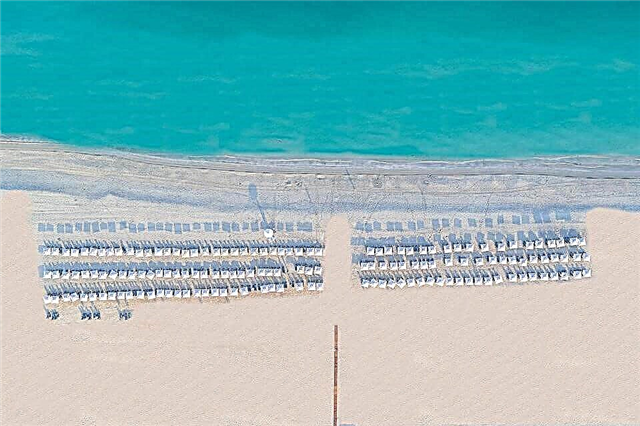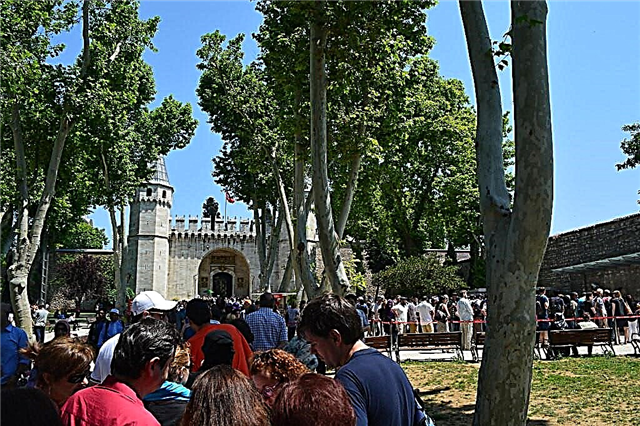Address: Russia, St. Petersburg, st. Blokhin, 26
Building: 1766 - 1789
Architect: Antonio Rinaldi
Coordinates: 59 ° 57'06.1 "N 30 ° 17'43.9" E
Object of cultural heritage of the peoples of the Russian Federation
Content:
On one of the islands, which are located at the mouth of the Neva, there is a beautiful cathedral-basilica with a slender high bell tower. The architectural monument was built at the end of the 18th century and occupies a special place among the cathedrals and churches of St. Petersburg. Nowadays, several ancient icons are kept in the Prince Vladimir Cathedral, and many townspeople and tourists come under its arches.

Prince Vladimir Cathedral from a bird's eye view
Precursor temples
The first church on the low-lying, swampy right bank of the Neva appeared in 1709, during the construction of the streets of St. Petersburg. It was a small wooden church consecrated in honor of St. Nicholas.
In 1713-1719, a new hut cathedral was built in its place. It was consecrated by the Metropolitan of Ryazan and Murom Stephen in the presence of Emperor Peter I. When the wayward Neva overflowed, the water flooded all the surrounding neighborhoods. The new church also suffered, so the locals called it the Assumption-on-Mokrushe or the Church of St. Nicholas the Wet.
In 1740, during the reign of Empress Anna Ioannovna, it was decided to build a large stone cathedral on the memorial site. In honor of her father Ivan Alekseevich, the queen ordered to dedicate the temple to John Chrysostom. The initial project was created by architects Mikhail Grigorievich Zemtsov and Pietro Antonio Trezzini. The craftsmen managed to lay the foundation and raise the stone walls. But when Elizaveta Petrovna ascended the throne, the construction site was frozen.

View of the Prince Vladimir Cathedral from the Malaya Neva River
Cathedral history
Empress Catherine II commissioned the talented architect Antonio Rinaldi to take care of the cathedral. The Empress wanted the new church to be similar to the Assumption Cathedral in the Moscow Kremlin. She ordered to build a five-domed cathedral at the mouth of the Neva and erect a high three-tiered bell tower near it. The architect took into account all the wishes of Catherine II. When the project was ready, construction was resumed with renewed vigor.
In 1783, the cathedral was completed, and 6 years later it was consecrated in honor of St. Vladimir. The Equal-to-the-Apostles prince remained in history as a baptist and reformer of Russia, therefore his name was revered by all believers. In 1806, a Theological School was opened at the church, where they began to train priests for the local diocese.
In the 70s of the XIX century, a charitable society appeared in the cathedral, and at the beginning of the last century - an orphanage for children and a parish school. Orphans and children of poor townspeople could receive primary education and master useful crafts. In the future, they got a job and had a piece of bread. During the First World War, an infirmary with 16 beds was opened at the cathedral, in which wounded soldiers and officers were treated.

View of the Prince Vladimir Cathedral from the side of Dobrolyubov Avenue
After the revolutionary events of 1917, the attitude towards the Church in the country changed. Until the mid-1920s, the cathedral was ruled by "renovationists" who actively collaborated with the new government. Then the services were stopped for two years, and from 1928 the services began to be held again.
In the 1930s, an active anti-religious campaign took place in the country. Churches were closed en masse in villages and large cities. Solid temple buildings were dismantled into bricks or simply destroyed with explosives. In 1933, the bells were removed from the Prince Vladimir Cathedral and sent to be melted down. In addition, many revered shrines and valuable liturgical utensils were taken out of the church.
By 1934, the temple remained the only one on the Petrograd side. During the Great Terror, the authorities shot the rector of the cathedral, Bishop Tikhon of Cherepovets, Archpriest Mikhail Dolotov and Protodeacon John Gonestov.

View of the bell tower of the Prince Vladimir Cathedral
Before the war, the cathedral received the status of a cathedral church, so the metropolitan's residence was located here. From September 1940 to July 2001, one of the revered shrines was kept here - a list of the famous icon of the Kazan Mother of God. Now this image is in the Kazan Cathedral of the city.
In the difficult days of the Leningrad blockade, believers could always come to church for prayer and attend services. The doors of the cathedral were not closed for a single day. In 1946, the bells were restored, so the temple regained its voice.
The order
An important event took place in 1845. The cathedral received the status of a capitular or main temple of the imperial order of St. Vladimir. The honorary award was established under Catherine II and was awarded for civilian distinctions and special military merits. The order had 4 degrees. Its owners received an annual pension of 100 to 600 rubles, and the 4-degree holders of the Order were hereditary nobility.

Cathedral domes
The award was presented to the military in the rank of the lieutenant colonel and Russian officials of the middle rank. Among the famous holders of the Order of St. Vladimir are Field Marshal Alexander Golitsyn, Admiral Dmitry Senyavin, Commander of the Black Sea Fleet Fedor Ushakov, generals Alexander Suvorov and Mikhail Barclay de Tolly.
At the request of the knights of the order, a special order holiday was celebrated annually on September 22 in the church. On this day, a solemn bishop's service and a prayer service with hymns in honor of Prince Vladimir were held.
Today, above the entrance to the cathedral, you can see two gilded angels, and between them is a large model of the Imperial Order of St. Vladimir. A proud motto is written in the middle of the round plafond: "Benefit, honor and glory."

Angels and the Order of St. Vladimir over the entrance to the cathedral
Architectural features
The St. Petersburg temple has the shape of an equal-pointed cross and from the side it resembles a large sailing ship. The cathedral is designed for 3000 believers. In its appearance, the influences of different styles are noticeable - from the late baroque to classicism.
The yellow-white main volume is crowned with a beautiful five-domed head. Openwork gilded crosses rise above each dome, the drawing for which was created by Antonio Rinaldi himself. The walls of the cathedral are divided by strict pilasters of the Doric order.
Everyone admires the bell tower, which rises 57 m above the green square. It serves as a noticeable landmark for ships and small vessels heading from the bay to the Malaya Neva. There are 7 large bells on the bell tower. The largest, weighing 5 tons, was cast in 1779.

View of the Prince Vladimir Cathedral from Talalikhin Lane
The surrounding buildings of the Petrogradsky district are noticeably lower than the temple bell tower. Only the high spire of the Peter and Paul Cathedral, which is located 1.2 km from the east, on the territory of the Peter and Paul Fortress, can compete with it.
Interiors and expositions
Inside, the cozy basilica is divided into three naves and is painted in blue and white. Its decoration is discreet and simple. In the cathedral, you can see the images of the four Evangelists. Art critics suggest that their author is the famous painter Karl Bryullov.

Several Bible quotes are posted next to the main dome. There are no other murals in the cathedral. The magnificent temple iconostasis in the Empire style is considered a real masterpiece of wood carving.
Of particular interest are the 6 m long expositions of life-size figures. They are made outside, next to the entrance to the cathedral. Here are the Easter theme, the Nativity scene, the "Enlighteners" exposition and figures dedicated to Prince Vladimir.
Useful information for tourists and pilgrims
The last restoration of the cathedral was carried out in 2015, on the occasion of the 1000th anniversary of the birth of Prince Vladimir. The builders have renewed the facades, domes, roof and crosses. After a major reconstruction, the church looks great. The cathedral looks especially impressive in the evenings, when the building is illuminated by bright spotlights.

General view of the Prince Vladimir Cathedral, in the distance you can see the sports complex "Petrovsky"
One of the favorite Orthodox churches of St. Petersburg is open every day from 6:45 to 20:00. Free admission.
The cathedral has three limits. The main one is consecrated in honor of St. Vladimir, the northern one is dedicated to Nicholas the Wonderworker, and the southern one is dedicated to the Dormition of the Most Holy Theotokos. Services are held twice a day - at 10:00 and 18:00 on weekdays, at 7:00, 10:00 and 18:00 on Sundays and holidays. Services to Lent are at 9:00 and 18:00.
A Sunday school, a library of Orthodox literature and a pilgrimage center are open at the cathedral. Children and adults are engaged in the choir. There is a tea shop for visitors, where hot tea, rolls and coffee are always on sale.

The interior decoration of the Prince Vladimir Cathedral
How to get there
The cathedral is located in the Petrogradskiy district of the city, not far from the Peter and Paul Fortress, on Blokhin Street, 26. Near the park where the temple stands, there is an exit from the Sportivnaya metro station.











